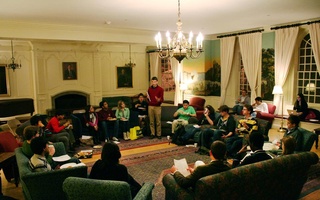THE BREAKING POINT
But by 1969, everything had changed. As the conflict in Vietnam entered its fourteenth year and changes in the draft rules prevented ROTC from serving as a viable deferral of service, anti-military protests swept across college campuses, including Harvard.
In the years before the April 9 takeover of University Hall, tensions between student demonstrators, administrators, and the military’s place on campus had grown. In 1967, 800 students protested the appearance of Defense Secretary Robert S. McNamara at the Institute of Politics, and the following year 300 protesters imprisoned a recruiter from Dow Chemical, which manufactured napalm for use in Vietnam, in a campus building. In December before the University Hall takeover, 100 students organized a sit-in at Paine Hall after being barred from Faculty meetings debating ROTC.
Already, the administration began to budge. In February, the Faculty voted to withdraw academic credit for ROTC. By that April, Kazin and other leaders of the SDS had decided that it was time to take bold action against the administration.
“It was not only the war they objected to but the whole establishment with a ‘capital E’ that was responsible for this,” Government Professor Harvey C. Mansfield ’53, who has been on the faculty since 1962, says. “Part of this was the feeling that the whole country was too militaristic. It wasn’t just that this was a wrong war in the wrong place.”
According to Kazin, anti-Vietnam protesters at Harvard made ROTC a central issue because it represented a concrete way to tie the administration to the unpopular war effort, a symbol of the University’s complicity.
With this in mind, the SDS, in a move consciously reminiscent of Luther’s stand at the church of Wittenberg, tacked their demands to President Pusey’s door, setting off the following two weeks of protests.
Eight days after students seized University Hall, the Faculty voted to relegate ROTC to the status of a regular extracurricular organization, effectively cutting it off from necessary resources. The faculty vote was overwhelmingly in favor the resolution, and it passed by a 385-25 margin.
FADING FROM THE SCENE
In the years immediately following ROTC’s departure from Harvard, the military, along with the opposition to it, faded into the background of campus debate.
When Michael M. Segal ’76, a current leader of Advocates for Harvard ROTC, came to campus there was no way for Harvard students to participate in ROTC. Shannon Hall, the former headquarters of the Harvard ROTC detachment had been converted into a daycare center.
But by the time Segal had graduated, the standoff eased and Harvard students could enroll in ROTC classes and training at MIT beginning in 1976. Harvard alumni have footed the bill for Harvard cadets for much of this time. This arrangement has remained relatively unchanged over the intervening three decades.
Meanwhile, changes in the American political landscape tempered the anti-military sentiment that drove ROTC off campus. As Mansfield explains, the conservative backlash of the later decades of the 20th century—much of it a consequence of the very movement that severed Harvard’s ties with ROTC—led to an increasing acceptance of the military.
Over time, the debate over ROTC shifted to a focus on the military’s recruitment practices, which under “Don’t Ask Don’t Tell” prohibited gays and lesbians from openly serving in the military.
For pro-ROTC groups, this represented a significant shift away from the anti-militarism of the sixties.
Read more in News
Facing Crime on CampusRecommended Articles
-
ROTC? ROFL!To recognize ROTC would not be to violate the University’s policy against discrimination.
-
Keep ROTC Out of RangePromising to reinstate ROTC simply to pressure a repeal of DADT is short-sighted
-
 ROTC Faces Uphill Battle
ROTC Faces Uphill Battle -
Activists Say Military's Policy Remains BiasedThe Harvard Trans Task Force (TTF) is circulating an online petition protesting the possible return of the Reserve Officers’ Training Corps before the military allows trans-identified and intersex individuals to openly serve in the military.
-
 Harvard Political Union Debates ROTC
Harvard Political Union Debates ROTC -
 In Rapprochement, University Hosts Welcome Reception For Veterans
In Rapprochement, University Hosts Welcome Reception For Veterans













